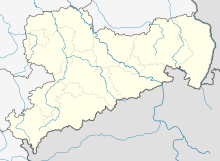Buttermilk mill
The submerged buttermilk mill was a water mill in Saxon Switzerland . The mill was located just above the confluence of the Schwarzbach and the Sebnitz .
history
The buttermilk mill was built in 1844/45 by the Altendorf farmer Karl Gottlob Michel as a grinding and cutting mill. The name of the mill was derived from the " Buttermilchfleckchen ", the piece of meadow on which it was built.
The operation of the mill turned out to be difficult, however, as numerous other mills already existed in the area. Already in 1854 the mill changed hands, and the new miller was Karl Gottlieb Leberecht Mitzscherling. Mitzscherling took over economically, so that the buttermilk mill was acquired by Ernst Wilhelm Albert in a foreclosure auction in 1871 . Albert already ran the Hertigswald mill, so he leased the buttermilk mill.
In the course of the construction of the Sebnitztalbahn , drinks began to be served in the buttermilk mill for the construction workers of the railway line. From 1877, Johann Kappler was the leaseholder of the buttermilk mill, who also built a bread bakery to serve drinks. The mill quickly developed into a popular retreat.
In 1891 the Ulbersdorf manor owner Dietrich von Carlowitz bought the buttermilk mill to convert it into a sawmill. The plans came to nothing, however, as von Carlowitz sold his possessions on in 1893. The new owner was Alphons Friedrich von Gontard, who leased the mill.
In 1912 the buttermilk mill then became the property of Alwin Köhler, who received the full catering license for the property and dedicated himself entirely to tourism. Müller stopped the milling operation and set up a guest room and several guest rooms instead. Also due to its location on the Sebnitztalbahn, the buttermilk mill continued to develop into a popular excursion destination.
In 1960 the mill was converted into a company holiday home. In 1985 the buttermilk mill burned down by lightning and was completely demolished in 1992. Today, apart from a short section of the Mühlgraben and a former storage cellar on the Sebnitz valley slope, nothing of the structure is visible. There is now a resting place at the site of the buttermilk mill.
St. Michaelis Stolln
About 50 meters above the buttermilk mill is located on the southern bank of the Sebnitz popularly the "gold hole" called "St. Michaelis Stolln" . The tunnel was already excavated in the granodiorite of the Lausitz, as it lies just east of the Lausitz Fault . The small mine probably goes back to the "Holy Trinity" pit, mentioned in 1563 . In 1753 the tunnel operation was resumed by the Steiger JC Häntzschel in the hope of copper gravel . The tunnel was driven for a length of almost 80 meters, but then came to a standstill as a result of the Seven Years' War . Apart from small amounts of galena , however, no ore was found, so that the operation of the tunnel was part of a series of further unsuccessful mining attempts in Saxon Switzerland in the 18th century. The tunnel now serves as a bat roost.
gallery
Individual evidence
- ↑ In terms of natural space , the buttermilk mill can already be assigned to the West Lusatian hills and mountains (cf. land mapping of the natural space units in Saxony ). In terms of regional history, Saxon Switzerland also includes adjacent parts of the West Lusatian hills and mountains and the Upper Lusatian mountains within the boundaries of the landscape protection area of the same name (cf. SMUL / NP Sächsische Schweiz: Sächsische Schweiz. Landeskundliche Abhandlung Natur - Mensch - Kultur. Dresden / Bad Schandau 1998 , P. 12ff.)
- ↑ It may also have been a matter of rebuilding or fundamentally converting an existing mill. The Deutsche Fotothek has a "view of the buttermilk mill in the Schwarzbachtal in Saxon Switzerland" dated "around 1825" (see [1] ).
- ↑ Manfred Schober : The mills of Saxon Switzerland. Right Elbe area. , Dresden 2009, p. 103
- ↑ The buttermilk mill at www.wandern-saechsische-schweiz.de ( Memento of the original from December 3, 2011 in the Internet Archive ) Info: The archive link was automatically inserted and not yet checked. Please check the original and archive link according to the instructions and then remove this notice.
- ^ W. Reichel et al .: Gold soaps and ore mining in the eastern Meißner highlands. Geologica Saxonica 58 (2012), Dresden 2015, pp. 83f. ( Digitized version )
literature
- Between Sebnitz, Hinterhermsdorf and the Zschirnsteinen (= values of the German homeland . Volume 2). 1st edition. Akademie Verlag, Berlin 1959. (Buttermilchmühle, p. 49f.)
- S. Börtitz, W. Eibisch: The caves of Saxon Switzerland. in: Jahrb. Staatl. Mus. Mineral. Geol. 1962, Dresden 1962, pp. 177–264 (St.-Michaelis-Stolln, pp. 254f.)
- Alfred Meiche : A mill book. Dresden 1927 (Buttermilchmühle, pp. 49–52)
- W. Reichel et al .: Gold soaps and ore mining in the eastern Meißner highlands. Geologica Saxonica 58 (2012), Dresden 2015 (St.-Michaelis-Stolln, p. 83f.)
- Manfred Schober: The mills of Saxon Switzerland. Right Elbe area. , Dresden 2009 (Buttermilchmühle, p. 105f.)




